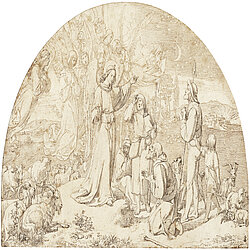Loading the page ...
Joseph von Führich
1800 Kratzau – 1876 Vienna
Born in the north Bohemian town of Kratzau (now Chrastava), the artist was first taught by his father, Wenzel Führich. In 1819, Führich scored a great succès d’estime with two pictures he contributed to the annual exhibition of the Prague Academy. Sponsored by Count Christian Clam-Gallas, he began to study art at that same Academy the following year. In the early 1820s Führich was intensely preoccupied with the ideas of the Romantic movement, reading Novalis, Tieck, Wackenroder and the writings of the two Schlegel brothers, while also distinguishing himself as an illustrator. His illustrations for Tieck’s Genoveva, on which the artist worked in the years 1824–25, turned out to be a great artistic success and, thanks to the intervention of Prince Metternich, earned him a grant for a study trip to Italy. Early in 1827 Führich arrived in Rome, where he moved in the circle of German artists who met in the Café Greco, and made the acquaintance, through Joseph Anton Koch, of the Nazarenes Julius Schnorr von Carolsfeld, Philipp Veit and Friedrich Overbeck. This connection turned out to be so fruitful and inspiring that Führich soon joined the Brotherhood of Saint Luke and identified himself completely with its artistic and religious activities. From 1827 to 1829, Führich took part, under the supervision of Overbeck, in the completion of the frescoes in the Tasso Hall in the Casino Massimo before returning to Prague in summer 1829.
Archive
